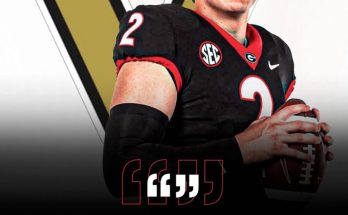The appointment of Kalen DeBoer as the head football coach of Alabama sent shockwaves through the college football world, but not for the reasons most fans and analysts expected. While DeBoer is widely regarded as one of the brightest offensive minds in the game, his selection to replace a coach of Nick Saban’s stature, given the deep-rooted legacy and championship expectations surrounding Alabama football, led to a series of challenges that have put the Crimson Tide behind in multiple ways. The decision to hire DeBoer not only raised questions about Alabama’s future but also created a ripple effect that impacted the program’s recruitment, roster management, and overall identity.
The Immediate Fallout
When Kalen DeBoer was announced as the successor to Nick Saban, the immediate reaction was one of disbelief and confusion from both Alabama fans and pundits around the country. Saban’s tenure had brought unparalleled success to the Crimson Tide, including six national championships, and his departure marked the end of an era. Most expected Alabama to select a coach with a similar pedigree—someone who had experience in high-pressure environments and a proven track record of developing championship-caliber teams.
DeBoer, on the other hand, was an unconventional choice. Having spent the majority of his career at smaller programs like Fresno State and Washington, he had never been in charge of a program at the same level as Alabama, nor had he faced the type of intense expectations that come with being the head coach of one of the most storied programs in college football history. His successes at the smaller schools were undeniable—his offenses were prolific, and his ability to rebuild programs was impressive. But stepping into the giant shoes of Nick Saban was a different challenge altogether.
While DeBoer’s hiring initially created excitement for the future of Alabama’s offense, it also raised a number of concerns. Would he be able to handle the immense pressure of coaching a blue-blood program like Alabama? Would he be able to recruit and build the same kind of defensive juggernauts that Saban had crafted over the years? And perhaps most importantly, could he win championships in the hyper-competitive SEC, where every game is a battle, and expectations are always set to the highest standard?
Recruiting Setbacks
One of the most immediate consequences of Kalen DeBoer’s hire was its impact on Alabama’s recruiting efforts. Recruiting is the lifeblood of any top-tier college football program, and under Nick Saban, Alabama had established itself as a recruiting machine. Saban’s ability to pull in top-tier talent from across the country was unparalleled, and his approach to recruiting not only brought in elite players but also set a tone of dominance that intimidated other programs. Alabama was, for the most part, a recruiting destination that many players dreamed of.
DeBoer’s hire, however, created uncertainty in the recruiting world. High school recruits and their families are often drawn to stability and consistency in a coaching staff, and when Saban—one of the most successful coaches in the history of college football—decided to step down, that foundation was shaken. While DeBoer’s success at Fresno State and Washington had earned him respect, it wasn’t enough to automatically establish the same level of trust among the top-tier recruits that Saban had enjoyed.
Some recruits who had initially committed to Alabama began to reconsider their choices. Questions about DeBoer’s ability to maintain the same level of excellence, especially on the defensive side of the ball, began to linger. As one of the country’s premier football programs, Alabama had always been able to land elite players on both sides of the ball. But under DeBoer’s leadership, there were concerns that the team would shift its focus too heavily toward the offensive side, potentially leading to an imbalance in recruiting.
Several high-profile recruits, especially those on the defensive side of the ball, started to look elsewhere, unsure of what the future under DeBoer would look like. This disruption in recruiting efforts led to a decline in Alabama’s once-commanding position in the national rankings. As DeBoer worked to build relationships with recruits, it became apparent that the road ahead would be more challenging than expected.
The Identity Crisis
Perhaps the most significant impact of DeBoer’s selection as Alabama’s head coach was the identity crisis that followed. Alabama football, under Nick Saban, had become synonymous with a disciplined, defensively dominant style of play. Saban built his dynasty on an unrelenting defense, where the Crimson Tide controlled the line of scrimmage, suffocated opposing offenses, and allowed their offense to make big plays when needed. The defense was always the backbone of the program, and it served as a foundation for Alabama’s sustained excellence.
DeBoer’s hiring, however, signaled a shift toward an offense-first philosophy. Known for his innovative offensive schemes and the ability to develop high-powered attacks, DeBoer was viewed by many as a great offensive mind, but his background did not align with the traditional defensive identity that had been the hallmark of Alabama football under Saban. The question quickly arose: could DeBoer build a championship-caliber defense to complement his offense, or would Alabama’s defense take a backseat to the offense?
In the SEC, where defense is paramount, this shift in philosophy was met with resistance from both fans and former players. Alabama’s fanbase had grown accustomed to the dominance of its defense, and while the offensive side of the ball had certainly flourished under Saban, the foundation of Alabama’s success had always been its defensive prowess. DeBoer’s emphasis on the offensive side, while undoubtedly exciting for fans who longed for high-scoring games, created an air of uncertainty around the program’s future direction.
Under DeBoer, Alabama was expected to evolve into a more balanced team, but the question remained: could he find the right defensive coordinator to maintain the Crimson Tide’s once-unrivaled defense? Without a top-tier defense, Alabama would struggle to compete against other SEC powerhouses such as Georgia, LSU, and even emerging teams like Ole Miss, who had made strides on both sides of the ball.
The identity crisis was compounded by the fact that Alabama fans had grown accustomed to the leadership of Nick Saban, who had not only built a championship team but had created a program that was an enduring symbol of excellence. Replacing Saban with DeBoer wasn’t just about adjusting to a new coach; it was about redefining the very soul of Alabama football. This transition has been challenging, with some fans and players still holding onto the memories of Saban’s dominant run.
Roster Management and Development
One of the most immediate challenges DeBoer faced was navigating Alabama’s roster management and player development. With Saban at the helm, Alabama had become a well-oiled machine in terms of player development. Under Saban’s strict regimen, players developed into elite athletes, and the depth of Alabama’s roster allowed them to withstand injuries and thrive throughout the brutal SEC schedule.
For DeBoer, however, inheriting such a high-caliber roster created its own set of challenges. The program had been built on a combination of elite talent and hard-nosed development, and shifting that culture to incorporate more offensive-minded principles while maintaining high standards on defense and special teams proved to be a difficult balancing act. Some players struggled to adjust to the new offensive system, while others found themselves unsure of their roles within the evolving program.
DeBoer’s challenge was to not only manage the current roster but also to develop young talent while adapting to the pressures of being Alabama’s head coach. The lack of continuity in player development, especially in the transition from Saban’s era, became evident as the team struggled to gel under DeBoer’s leadership. Additionally, Alabama’s offensive line, once a cornerstone of Saban’s system, experienced growing pains as DeBoer sought to implement his offensive philosophy without neglecting the fundamentals that had made Alabama so dominant.
Recruiting to a New System
Another significant setback for DeBoer’s Alabama was the challenge of recruiting to a new system. Alabama’s reputation for producing NFL-caliber players, especially on the defensive side of the ball, had been a major draw for top recruits. Under DeBoer’s more offensive-oriented approach, it became apparent that the team would need to adjust its recruiting efforts to appeal to a new generation of players who might prioritize playing in an explosive offensive system over traditional defensive dominance.
The shift in recruiting focus led to some growing pains. While DeBoer’s offensive prowess certainly appealed to quarterbacks and skilled position players, the defense remained a question mark. As the team struggled to find its identity, the recruiting process became increasingly challenging. The Crimson Tide began to lose ground to teams with established defensive traditions, such as Georgia and Clemson, who were able to sell recruits on the idea of playing in dominant defensive systems.
Conclusion
Kalen DeBoer’s selection as the head football coach of Alabama marked a significant departure from the program’s identity under Nick Saban. While DeBoer is undoubtedly a talented coach with a proven track record of success at smaller programs, his hire created several setbacks that have left the Crimson Tide behind in multiple ways. From the immediate impact on recruiting to the struggle with defining the team’s identity and navigating roster management challenges, DeBoer’s tenure has been marked by uncertainty and adjustment. For Alabama to regain its position among the elite teams in college football, DeBoer will need to address these issues head-on and prove that his offensive-focused philosophy can coexist with the high expectations that come with coaching a program of Alabama’s stature.



